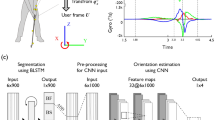Abstract
This paper describes an autonomous kinematic analysis platform for wrist angle measurement that is capable of evaluating a user’s uncocking motion in his or her golf swing and providing instructional multimodal feedback to improve his or her skills. This uncocking motion, which is a characteristic movement of the wrist during the golf swing, is an important factor in achieving accurate ball hitting and long driving distances, but is difficult to measure. In order to efficiently compute the wrist angle for uncocking evaluation, we present a sensor-based intelligent Inertial Measurement Unit (IMU) agent that collects three-dimensional orientation data during the golf swing from two IMU sensors placed on the forearm and on the golf club. It accurately analyzes changes in wrist angle to detect uncocking throughout the sequence of golf swing motions. In this paper, we first introduce the design considerations based on the concept of the uncocking motion and explain the system architecture with the sensors used for quantitative measurement and qualitative feedback generation. Then, we illustrate the detailed algorithms for wrist angle computation, golf swing motion segmentation based on key pose detection, and uncocking evaluation. A multimodal feedback-based user interface for our system is also presented. Experimental results show that the proposed system has the ability to accurately calculate the wrist angle in real time and also that it can be applied to a practical self-coaching system to improve the uncocking motion.














Similar content being viewed by others

References
Ball KA, Best RJ (2007) Different centre of pressure patterns within the golf stroke II: group-based analysis. J Sports Sci 25:771–779
Barrón C, Kakadiaris IA (2001) Estimating anthropometry and pose from a single uncalibrated image. Comput Vis Image Underst 81:269–284
FlightScope Kudu. http://www.flightscope.com/index.php/FlightScope-Radar/flightscope-kudu.html/. Accessed 3 Nov 2012
FMOD Library. http://www.fmod.org/fmod-downloads.html/. Accessed 3 Feb 2012
Fossati A, Dimitrijevic M, Lepetit V, Fua P (2010) From canonical poses to 3-d motion capture using a single camera. IEEE Trans Pattern Anal Mach Intel 32(7):1165–1181
Ghasemzadeh H, Loseu V, Guenterberg E, Jafari R (2009) Sport training using body sensor networks: A statistical approach to measure wrist rotation for golf swing. In: Proceedings of the fourth international workshop on body area networks, Los Angeles, CA, USA. doi: 10.4108/ICST.BODYNETS2009.6035
Ghasemzadeh H, Loseu V, Jafari R (2009) Wearable coach for sport training: a quantitative model to evaluate wrist-rotation in golf. J Ambient Intel Smart Environ 1:173–184
Gulgin H, Armstrong C, Gribble P (2009) Hip rotational velocities during the full golf swing. J Sports Sci Med 8:296–299
Hume PA, Keogh J, Reid D (2005) The role of biomechanics in maximizing distance and accuracy of golf shots. Sports Med 35:429–449
Huyghe B, Salvo P, Doutreloigne J, Vanfleteren J (2012) Feasibility study and performance analysis of a gyroless orientation tracker. IEEE Trans Instrum Meas 61(8):2274–2282
Ing WK (2011) Prototyping of body sensor and bowling sensor for sport coaching and entertainment purposes. http://soes.curtin.edu.my/v2/wp-content/uploads/2011/10/5RD-Magazine-July-2011.pdf. Accessed 24 October 2012
Joyce C, Burnett A, Ball K (2010) Methodological considerations for the 3D measurement of the X-factor and lower trunk movement in golf. Sports Biomech 9:206–221
Jung Y, Kang D, Kim J (2010) Upper body motion tracking with inertial sensors. In: Proceedings of IEEE international conference on robotics and biomimetics, pp 1746–1751
McTeigue M, Lamb SR, Mottram R (1994) Spine and hip motion analysis during the golf swing. Sci Golf II 50–58
Microsoft, USA. XBOX Kinect. doi:http://www.xbox.com/Kinect
Milburn PD (1982) Summation of segmental velocities in the golf swing. Med Sci Sports Exerc 14:60–64
Negoro H, Ueda M, Watanabe K, Kobayashi K, Kurihara Y (2011) An accelerometer based instrumentation of the golf club: measurement and signal analysis. In: Proceedings of SICE annual conference, pp 1111–1114
Okuda I, Gribble P, Armstrong C (2010) Trunk rotation and weight transfer patterns between skilled and low skilled golfers. J Sports Sci Med 9:127–133
OpenCV The open computer vision library. http://sourceforge.net/projects/opencvlibrary/. Accessed 20 Jan 2010
Park A, Kim J (2012) GPU accelerated vie synthesis from multiple rgb-d images. In: Proceedings of IEEE international conference on image processing, pp 573–576
PrimeSense. http://www.primsense.com/. Accessed 25 Dec 2011
Richards J, Farrell M, Kent J, Kraft R (1985) Weight transfer patterns during the golf swing. Res Q Exerc Sport 56:361–365
Shen Y and Foroosh H (2008) View-invariant action recognition using fundamental ratios. In: Proceedings of IEEE international conference on computer vision and pattern recognition, pp 1–6. doi: 10.1109/CVPR.2008.4587755
Shotton J, Fitzgibbon A, Cook M, Sharp T, Finocchio M, Moore R, Kipman A, Blake A (2011) Real-time human pose recognition in parts from single depth images. In: Proceedings of IEEE international conference on computer vision and pattern recognition, pp 1297–1304. doi: 10.1109/CVPR.2011.5995316
Tessendorf B, Gravenhorst F, Arnrich B, Tröster G (2011) An IMU-based sensor network to continuously monitor rowing technique on the water. In: Proceedings of ISSNIP, IEEE, pp 253–258
Urtasun R, Fleet DJ, Fua P (2005) Monocular 3D tracking of the golf swing. Proc IEEE Int Conf Comput Vis Pattern Recogn 2:932–938
Urtasun R, Fleet DJ, Fua P (2006) Temporal motion models for monocular and multiview 3D human body tracking. Comput Vis Image Underst 104(2):157–177
Watanabe K, Hokari M (2006) Kinematical analysis and measurement of sports form. IEEE Trans Syst Man Cybernetics Part A 36(3):549–557
Wheeler K, Nauright J (2006) A global perspective on the environmental impact of golf. Sport Soc 9(3):427–443
Acknowledgment
This work was supported in part by the IT R&D program of MKE/MCST/IITA (2008-F-033-02, Development of Real-time Physics Simulation Engine for e-Entertainment) and the Sports Industry R&D program of MCST (Development of VR based Tangible Sports System).
Author information
Authors and Affiliations
Corresponding author
Rights and permissions
About this article
Cite this article
Chun, S., Kang, D., Choi, HR. et al. A sensor-aided self coaching model for uncocking improvement in golf swing. Multimed Tools Appl 72, 253–279 (2014). https://doi.org/10.1007/s11042-013-1359-2
Published:
Issue Date:
DOI: https://doi.org/10.1007/s11042-013-1359-2



